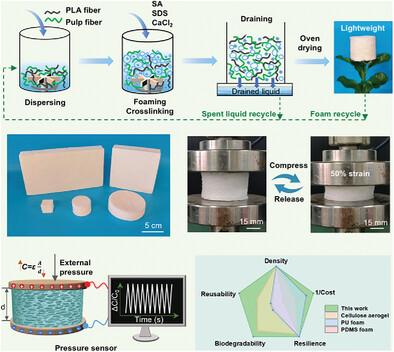Ultra-Elastic, Durable, Bio-Degradable, and Recyclable Pulp Foam as an Air Dielectric Substitute for Sustainable Capacitive Pressure Sensing
IF 18.5
1区 材料科学
Q1 CHEMISTRY, MULTIDISCIPLINARY
引用次数: 0
Abstract
Green carbon-based cellulosic pulp foams with excellent renewable and biodegradable properties are promising alternatives to traditional petroleum-based lightweight materials, for reducing carbon emission and plastic pollution. However, the fabrication of super-elastic and durable pulp-based foams for high-value utilization remains challenging. Herein, a novel composite bio-foam material is prepared by a simple strategy of wet foaming and ionically cross-linking. The obtained foam assembled by cellulosic pulp fibers and polylactic acid (PLA) fibers at atmospheric pressure shows an oriented lamellar structure with interconnected macropores and super-elastic property. The prepared PLA@Pulp-20 foam shows a high compressive strain of up to 90% with the maximum stress of 150 kPa, while retaining ≈91% of its original height even after 30 000 compressive cycles (far superior to the reported pulp-based foams with compressive cycles <10). Furthermore, the foam exhibits outstanding recyclability and stability in a wide range of temperature and humidity. Remarkably, the potential application of PLA@Pulp foam as a dielectric layer for capacitive sensors is first demonstrated because of its electrical non-conductivity, and low dielectric constant (comparable to air). The corresponding device achieves non-contact touch or contact touch sensing, demonstrating highly attractive performance in sustainable super-elastic pressure sensing, monitoring, and beyond.

求助全文
约1分钟内获得全文
求助全文
来源期刊

Advanced Functional Materials
工程技术-材料科学:综合
CiteScore
29.50
自引率
4.20%
发文量
2086
审稿时长
2.1 months
期刊介绍:
Firmly established as a top-tier materials science journal, Advanced Functional Materials reports breakthrough research in all aspects of materials science, including nanotechnology, chemistry, physics, and biology every week.
Advanced Functional Materials is known for its rapid and fair peer review, quality content, and high impact, making it the first choice of the international materials science community.
 求助内容:
求助内容: 应助结果提醒方式:
应助结果提醒方式:


